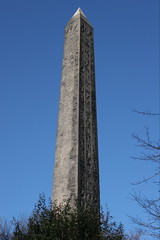 An obelisk (from Greek ὀβελίσκος - obeliskos,[1] diminutive of ὀβελός - obelos, "spit, nail, pointed pillar"[2]) (المسلة Al-Masalla in Arabic) is a tall, narrow, four-sided, tapering monument which ends in a pyramidal top. Ancient obelisks were made of a single piece of stone (a monolith); however, most modern obelisks are made of individual stones, and can even have interior spaces. The original form is Egyptian and all subsequent versions are derived from the original Egyptian pattern," says Wikipedia.
An obelisk (from Greek ὀβελίσκος - obeliskos,[1] diminutive of ὀβελός - obelos, "spit, nail, pointed pillar"[2]) (المسلة Al-Masalla in Arabic) is a tall, narrow, four-sided, tapering monument which ends in a pyramidal top. Ancient obelisks were made of a single piece of stone (a monolith); however, most modern obelisks are made of individual stones, and can even have interior spaces. The original form is Egyptian and all subsequent versions are derived from the original Egyptian pattern," says Wikipedia.The term stele (plural: stelae) is generally used for other monumental standing inscribed sculpted stones.
Obelisks were prominent in the architecture of the ancient Egyptians, who placed them in pairs at the entrance of temples. The word "obelisk" is of Greek rather than Egyptian origin because Herodotus, the Greek traveler, was the first to describe the objects. Twenty-nine ancient Egyptian obelisks are known to have survived, plus the "Unfinished Obelisk" found partly hewn from its quarry at Aswan. These obelisks are now dispersed around the world, and only nine remain in Egypt.
The earliest temple obelisk still in its original position is the 20.7 m / 68 ft high red granite Obelisk of Senusret I of the XIIth Dynasty at Al-Matariyyah part of Heliopolis.[3]
The obelisk symbolized the sun god Ra, or Re, and during the brief religious reformation of Akhenaten was said to be a petrified ray of the Aten, the sundisk. It was also thought that the god existed within the structure.
It is hypothesized by New York University Egyptologist Patricia Blackwell Gary and Astronomy senior editor Richard Talcott that the shapes of the ancient Egyptian pyramid and obelisk were derived from natural phenomena associated with the sun (the sun-god Ra being the Egyptians' greatest deity).[4] The pyramid and obelisk would have been inspired by previously overlooked astronomical phenomena connected with sunrise and sunset: the zodiacal light and sun pillars respectively.
The Ancient Romans were strongly influenced by the obelisk form, to the extent that there are now more than twice as many obelisks standing in Rome as remain in Egypt.
No comments:
Post a Comment